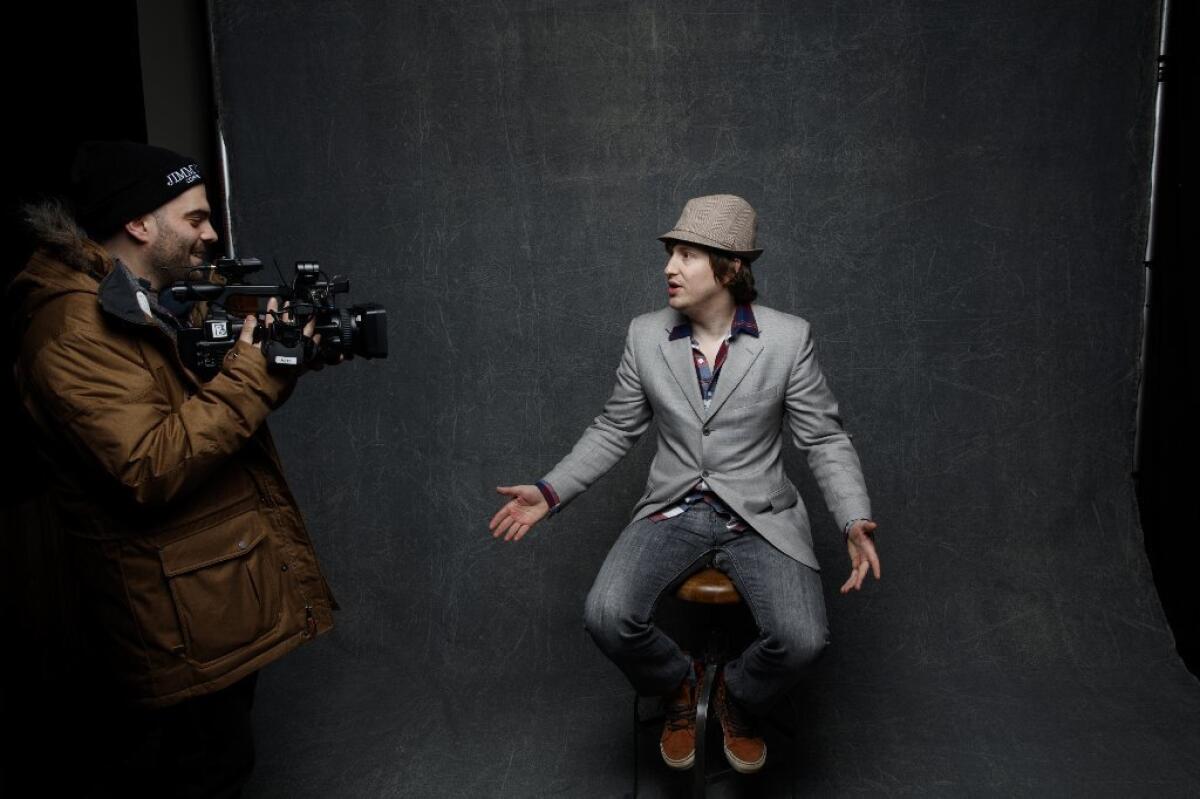How director Matt Johnson fell for ‘Operation Avalanche,’ a fake doc about faking the moon landing

- Share via
For his first film, 2013’s “The Dirties,” which revolved around two high school friends making a film about the school’s bullies that goes awry, Matt Johnson wanted to make it so authentic he enrolled in a high school and convinced students and teachers he was an actual student.
After “The Dirties” picked up the grand jury prize at the Slamdance Film Festival, the 31-year-old Toronto-based filmmaker and his crew thought about expanding the model they created for the first film and make a period documentary.
The end result is the clever found-footage conspiracy thriller “Operation Avalanche,” which premiered in January at Sundance and opened Friday at the Nuart Theater in West Los Angeles.
The film is set during NASA’s Apollo program in the 1960s. Johnson and Owen Williams plays nerdy CIA agents, aptly named Matt Johnson and Owen Williams, who go undercover as documentary filmmakers at NASA to investigate the possibility of a Russian mole at the space center. After they learn that the NASA won’t make it to the moon by 1969, they convince the CIA they can shoot a fake moon landing.

The trailer for “Operation Avalanche.”
And just as in the movie, Johnson and his small cast and crew were able to persuade the Johnson Space Center in Galveston, Texas to let them shoot there.
Inspired by “Zelig” and “Forrest Gump,” Johnson and his crew blend new footage they shot with historical clips from that era. And Johnson even interacts with Stanley Kubrick when the CIA gang visits Shepperton Studios when the legendary filmmaker was directing “2001: A Space Odyssey.”
Johnson, who recently received a master’s degree in film at York University in Toronto, chatted on the phone from his hometown this week.
It seemed awfully easy to for you and your crew to get permission from NASA to film there by telling them you were college students doing a documentary on the Apollo mission.
Well, I was a college student. This is my master’s project.
But you didn’t tell them it was a conspiracy film?
No, we didn’t say that. I said I was making a movie about NASA in the 1960s, which is true. But the centerpiece of it was NASA not being able to make it to the moon — the CIA faking a moon landing. At the time we didn’t even know if we were going to be possible to make this movie because we needed to get certain “stuff” from NASA.
Was the “stuff” you needed that historical footage from the Apollo program?
We needed them to [find] the film clips, which they did, which was really amazing. Right now that photographic department is closed at NASA, sadly. NASA is criminally underfunded. Our production company is the largest individual carrier of NASA archival footage in the world. It’s actually kind of sad.
Besides going to NASA you also visited Shepperton Studios where Kubrick shot “2001: A Space Odyssey.” Did you tell the officials at Shepperton what you were up to?
No. That was very different. Jared Raab, one of the [directors of photography], and I [were] going to England — “The Dirties” was being released and we went over [to promote] that movie. We took a train to Shepperton and thought we would just try to go on tour and take some pictures. But our tour guide never showed up. We just just took the visitor pass security handed us and just ran to get these shots — until security grabbed us and threw us out. We almost got in a lot of trouble. We were able to get away, claiming we were just Canadian students.
How did you achieve the vintage cinema verite 16-millimeter style of the film? Was it shot on 16 and then transferred to digital?
That was our first big challenge. We started shooting the color footage on 16 and then we started realizing that we were shooting so much footage — we were going through 10,000 feet a day. We realized we could get a film artist to [reprint digital footage] on 16mm. Conor Fisher used a lab and did a one-to-one exchange of every single frame of the film. It took him four months.
We did a full color grade on the digital and then our film artist did multiple prints on different film stocks to get different [looks]. We did physical damage. I took a piece of the movie, hung it on my bike and rode my bike around the university campus so that it would get all destroyed.
Even though you have lived your entire life in Toronto, you decided not to have “Operation Avalanche” premiere at the Toronto International Film Festival last fall, for Sundance this past January.
That was really important to me to screen at Sundance. Young filmmakers screening their own work in their own cities, you never get the reception that international filmmakers get, especially in Toronto. They promote outsiders, they don’t just with Canadians. We just don’t have the same celebrity culture around our arts. You have to have made it in the States before Canadians will acknowledge you, which is so sad.
So I have to ask: Since “Operation Avalanche” was your master’s thesis, what grade did you get?
You know what? It’s pass/fail. I passed. My professors were really happy with the film. They thought I was crazy at first, but in the end I think they were surprised I was able to do it.
More to Read
Only good movies
Get the Indie Focus newsletter, Mark Olsen's weekly guide to the world of cinema.
You may occasionally receive promotional content from the Los Angeles Times.











